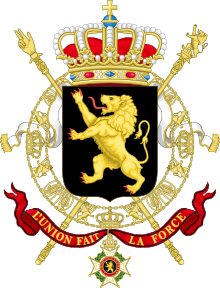1890 Belgian general election
Partial general elections were held in Belgium on 10 June 1890.[1][2] In the elections for the Chamber of Representatives the result was a victory for the Catholic Party, which won 94 of the 138 seats.[2]
| |||||||||||||||||||||||||||||||
69 of the 138 seats in the Chamber of Representatives 70 seats needed for a majority | |||||||||||||||||||||||||||||||
|---|---|---|---|---|---|---|---|---|---|---|---|---|---|---|---|---|---|---|---|---|---|---|---|---|---|---|---|---|---|---|---|
| |||||||||||||||||||||||||||||||
| |||||||||||||||||||||||||||||||
 |
|---|
| This article is part of a series on the politics and government of Belgium |
|
|
|
|
Federal Cabinet |
|
|
Under the alternating system, elections were held in only four out of the nine provinces: Hainaut, Limburg, Liège and East Flanders. Thus, only 69 seats out of the 138 were up for election. Additionally, a special election was held in Neufchâteau on 3 June 1890 after the death of Edmond van der Linden d'Hooghvorst (d).[3] Winand Heynen (d) was elected to replace him.
Results
Chamber of Representatives
| Party | Votes | % | Seats | ||
|---|---|---|---|---|---|
| Won | Total | +/– | |||
| Liberal Party | 20,829 | 54.5 | 40 | 44 | +4 |
| Catholic Party | 17,253 | 45.2 | 29 | 94 | –4 |
| Belgian Labour Party | 98 | 0.3 | 0 | 0 | New |
| Others | 30 | 0.1 | 0 | 0 | 0 |
| Invalid/blank votes | – | – | – | – | |
| Total | 38,210 | 100 | 69 | 138 | 0 |
| Registered voters/turnout | 59,452 | – | – | – | |
| Source: Mackie & Rose,[4] Sternberger et al. | |||||
Constituencies
The distribution of seats among the electoral districts was as follows:[5]
| Province | Arrondissement | Seats |
|---|---|---|
| Antwerp | Antwerp | 8 |
| Mechelen | 3 | |
| Turnhout | 3 | |
| Limburg | Hasselt | 2 |
| Maaseik | 1 | |
| Tongeren | 2 | |
| East Flanders | Aalst | 4 |
| Oudenaarde | 3 | |
| Gent | 8 | |
| Eeklo | 1 | |
| Dendermonde | 3 | |
| Sint-Niklaas | 3 | |
| West Flanders | Bruges | 3 |
| Roeselare | 2 | |
| Tielt | 2 | |
| Kortrijk | 4 | |
| Ypres | 3 | |
| Veurne | 1 | |
| Diksmuide | 1 | |
| Ostend | 1 | |
| Brabant | Leuven | 5 |
| Brussels | 16 | |
| Nivelles | 4 | |
| Hainaut | Tournai | 4 |
| Ath | 2 | |
| Charleroi | 7 | |
| Thuin | 3 | |
| Mons | 6 | |
| Soignies | 3 | |
| Liège | Huy | 2 |
| Waremme | 2 | |
| Liège | 9 | |
| Verviers | 4 | |
| Luxembourg | Arlon | 1 |
| Marche | 1 | |
| Bastogne | 1 | |
| Neufchâteau | 1 | |
| Virton | 1 | |
| Namur | Namur | 4 |
| Dinant | 2 | |
| Philippeville | 2 |
gollark: At 5FPS?
gollark: Or, in this case, discord machine.
gollark: Riiiiiight.
gollark: https://ark.intel.com/products/84672/Intel-Core-M-5Y71-Processor-4M-Cache-up-to-2_90-GHz
gollark: ... Sorry, m5, right?
References
- Codebook Constituency-level Elections Archive, 2003
- Sternberger, D, Vogel, B & Nohlen, D (1969) Die Wahl der Parlamente: Band I: Europa - Erster Halbband, p105
- Opening session of 8 July 1890
- Thomas T Mackie & Richard Rose (1991) The International Almanac of Electoral History, Macmillan, pp50–51
- List of members of the Chamber of Representatives (1890-1891)
This article is issued from Wikipedia. The text is licensed under Creative Commons - Attribution - Sharealike. Additional terms may apply for the media files.
.jpg)
